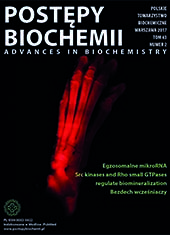Methods of analysis of protein phosphorylation
Abstract
Phosphorylation and dephosphorylation play a fundamental role in most signaling pathways, as these processes can directly regulate various aspects of protein function. It is estimated that there are about 100,000 potential phosphorylation sites in proteins encoded by the human genome and about 30â50% of all proteins in the cell can be phosphorylated, which is directly related to the functions they perform. To determine whether a given protein is phosphorylated, any changes in its mobility caused by this modification are examined during PAGE electrophoresis. Concurrently, tandem mass spectrometry (MS/MS) allows to identify specific phosphorylation sites. The next step involves the prediction (using in silico analysis) which kinases can phosphorylate a specific site in the given protein. Then, in order to verify the information obtained from databases, in vitro and/or in vivo experiments are carried out.
Downloads
Published
Issue
Section
License
All journal contents are distributed under the Creative Commons Attribution-ShareAlike 4.0 International (CC BY-SA 4.0) license. Everybody may use the content following terms: Attribution — You must give appropriate credit, provide a link to the license, and indicate if changes were made, ShareAlike — If you remix, transform, or build upon the material, you must distribute your contributions under the same license as the original. There are no additional restrictions — You may not apply legal terms or technological measures that legally restrict others from doing anything the license permits.
Copyright for all published papers © stays with the authors.
Copyright for the journal: © Polish Biochemical Society.




